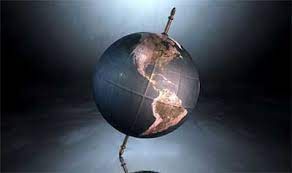UPSC Daily Current Affairs- 1st July 2023 | Current Affairs & Hindu Analysis: Daily, Weekly & Monthly PDF Download
GS-I
Groundwater extraction shifted the Earth’s axis
Why in News?
In June 2023, the study, ‘Drift of Earth’s Pole Confirms Groundwater Depletion as a Significant Contributor to Global Sea Level Rise 1993–2010’, was published in the journal Geophysical Research Letters.
Findings: Rise in Sea Levels
- Humans pumped out around 2,150 gigatons of groundwater for drinking and irrigation between 1993 and 2010.
- This excessive extraction of groundwater has shifted the Earth’s axis of rotation at the rate of 4.36 cm per year towards the east.
Impact
- The shift is not significant enough to have real-life consequences.
- Mass change on the equator or pole cannot affect change in the rotational pole. Rotational pole change is actually associated with the moment of inertia of the Earth, which is sensitive to midlatitude mass change.
- The water sucked out from the ground for irrigation and meeting the world’s freshwater demands, eventually, goes into the oceans.
Polar Motion
- Earth spins around an imaginary axis which passes through the north pole, its centre of mass and the south pole.
- The poles and the axis keep shifting naturally as the mass distribution in and on the planet changes. This phenomenon is known as “Polar Motion”.
- The shift of the axis “varies about several metres in a year.”
Reasons for Polar Motion
- Rocks slowly circulating inside Earth’s mantle causes the planet’s mass to shift, leading to a change in the position of the rotational axis.
- Other reasons for polar motion are ocean currents and even hurricanes.
- Climate-driven changes in water mass distribution, led by the melting of glaciers and ice in Greenland, can also cause Earth’s axis to drift.
Source: Indian Express
Just Energy Transition Partnership (JETP)
Why in News?
Senegal has joined the Just Energy Transition Partnership (JETP) deal, becoming the fourth country to sign after South Africa, Indonesia, and Vietnam.
- The deal aims to mobilize 5 billion euros in new financing for Senegal.
What is Just Energy Transition Partnership (JETP)?
- JETP is a financing mechanism that aims to support developing countries in their transition from fossil fuel-based energy systems to clean and renewable energy sources.
- JETP is designed to bridge the gap between wealthier nations and coal-dependent developing nations, addressing both the environmental and social aspects of the energy transition.
JETP Mechanism and Social Considerations
- JETPs provide financing to developing countries to phase out coal and transition to clean energy.
- Social aspects, such as protecting affected communities and providing job opportunities, are crucial in JETP plans.
- Reskilling, upskilling, and creating new jobs are essential components of a just energy transition.
Funding Sources and Donor Pool
- JETP funding can be provided through grants, loans, or investments.
- The International Partners Group (IPG) and the Glasgow Financial Alliance for Net Zero (GFANZ) Working Group are key contributors.
- The IPG includes countries such as Japan, the USA, Canada, Denmark, France, Germany, Italy, Norway, the EU, and the UK.
- The GFANZ Working Group comprises multilateral and national development banks and finance agencies.
JETP Success Stories
- South Africa was the first country to enter into a JETP at COP 26 Glasgow, with a pledge of 8.5 billion USD in financing.
- Indonesia announced its JETP at the G20 Bali Summit, receiving an initial 20 billion USD in public and private financing.
- Vietnam joined the JETP initiative, securing an initial fund of 15.5 billion USD over the next three to five years.
Prospects for India’s Participation
- Talks of a JET-P deal with India are ongoing but have not reached a final conclusion.
- Challenges include the complexity of India’s coal-based power sector and financing in the form of loans.
- India seeks favorable conditions and no compromise on energy security and development.
Source: The Hindu
GS-II
Election Commission
Why in News?
The Election Commission announced elections for 10 Rajya Sabha seats from three States that are falling vacant in July and August.
Background:-
About Election Commission:-
- The Election Commission is a permanent and independent body established by the Constitution of India.
- Objective: to ensure free and fair elections in the country.
- Article 324 of the Constitution: provides that the power of superintendence, direction and control of elections to parliament, state legislatures, the office of president of India and the office of vice-president of India shall be vested in the election commission.
Composition Election Commission of India:-
- Members: The election commission shall consist of the Chief Election Commissioner and a such number of other election commissioners, if any, as the President may from time to time fix.
- Appointment: The appointment of the chief election commissioner and other election commissioners shall be made by the
- Head: When any other election commissioner is so appointed the chief election commissioner shall act as the chairman of the election commission.
- Regional commissioners: The president may also appoint after consultation with the election commission such regional commissioners as he may consider necessary to assist the election commission.
- Procedure of Removal:-
- The Chief Election Commissioner can be removed from office only through a process of removal similar to that of a Supreme Court judge by Parliament.
- Judges of High Courts and Supreme Court, CEC, Comptroller and Auditor General (CAG) may be removed from office through a motion adopted by Parliament on grounds of ‘Proven misbehaviour or incapacity’.
- Removal requires a special majority of 2/3rd members present and voting supported by more than 50% of the total strength of the house.
- Conditions of service: it shall be such as the President may by rule.
- Tenure of office: President may by rule determine it.
Key Functions of ECI:-
- ECI superintendents, direct and control the entire process of conducting elections.
- These include elections to Parliament and Legislature of every State and to the offices of President and Vice-President of India.
- It decides the election schedules for the conduct of periodic and timely elections, whether general or bye-elections.
- It prepares electoral rolls and issues Electronic Photo Identity Cards (EPIC).
- It decides on the location of polling stations, assignment of voters to the polling stations, location of counting centres, and other related arrangements to be made.
- It grants recognition to political parties.
- It allots election symbols to them along with settling disputes related to it.
- Advisory jurisdiction: it can advise in the matter of post-election disqualification of sitting members of Parliament and State Legislatures.
- It issues the Model Code of Conduct in elections for political parties and candidates.
- Model Code of Conduct: a set of guidelines issued by the Election Commission of India for the conduct of political parties and candidates during elections.
- It sets limits of campaign expenditure per candidate to all the political parties and also monitors the same.
Rajya Sabha
- Article 80: The Constitution of India provides that the Rajya Sabha shall consist of 250 members.
- 12 members of these shall be nominated by the President from amongst persons having special knowledge or practical experience in respect of such matters as literature, science, art and social service.
- Not more than 238 representatives of the States and of the Union Territories.
- The Vice-President is the ex-officio chairperson of the Rajya Sabha.
- Deputy Chairman: elected from amongst the house’s members, takes care of the day-to-day matters of the house in the absence of the Chairman.
- Tenure of members: Every Rajya Sabha MP has a tenure of six years and elections to one-third of seats are held every two years.
Election of members:-
- Elections to the Rajya Sabha are
- Members representing States are elected by elected members of legislative assemblies of the States in accordance with the system of proportional representation by means of the single transferable vote.
- Each MLA’s vote is counted only once.
- To win a Rajya Sabha seat, a candidate should get the required number of votes.
- That number is found using the below formula.
- Required vote = Total number of votes / (Number of Rajya Sabha seats + 1 ) + 1.
Source: The Hindu
A model for quality and inclusive education
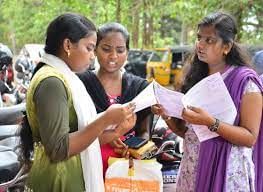
Why in News?
The National Institutional Ranking Framework (NIRF) is adopted by the Ministry of Education to rank institutions of higher education in India.
About National Institutional Ranking Framework (NIRF):
- It was launched by the Ministry for Human Resource Development (MHRD) [now Ministry of Education (MoE)] in September 2015.
- This framework outlines a methodology to rank institutions across the country.
Ranking Metric:
- The NIRF employs a ranking metric comprising five parameters with varying weightage to assess the quality of colleges:
- Teaching, Learning and Resources (40%),
- Graduation Outcome (25%),
- Research and Professional Practices (15%),
- Outreach and Inclusivity (10%) and
- Perception (10%).
- Each of these parameters has several components, which again have varying weightage.
- Though far from perfect, the metric is reasonably robust as it uses broad-based and curated parameters.
Learning from Top ranking states:
- Larger coverage of colleges: More than one-third of the top-ranked colleges are dispersed across different places; they not only cater largely to the rural and under-served areas, but also provide an opportunity for quality education for students from poor and disadvantaged social groups who do not have the economic resources and social networks to study in colleges.
- Reservation Policy: Tamil Nadu not only has one of the highest reservation quotas, but also has been quite effective in its implementation of the reservation policy.
Significance of Quality education in India:
- There is a severe learning crisis in India.
- Time and again this has been emphasized by several national and international level studies.
- The Annual Status of Education Report (ASER), stated that 50% of Class V students were unable to even read the text meant for students three levels below.
- Without immediate remedial assistance, these children cannot effectively progress in the education system.
- These future citizens will be low on skill level requirements of Industry 4.0.
- In the longer run, this will act as roadblock in the path of demographic dividend’s realization.
Criticisms of the ranking framework:
Insufficient quality parameters:
- The quality of an institution is a function of several inputs and the above indicators alone may not be sufficient.
- For example., how can we include the skills that an institution/university imparts to its students as one of the important ingredients? Should the financial health and size of the institution not be a criterion? etc.
One-size-fits-all approach:
- The diversity in the Indian education system is large.
- There are fresh as well as old institutions offering degrees/diplomas/certifications.
- There are also technology vs social sciences institutions, multi-disciplinary vs single discipline, private vs public, research-based, innovation-based, language-based or even special-purpose institutions/universities.
- The boundary conditions in which they operate are very different.
- NIRF seems to be committing the same sin that the global rankings systems were once accused of — a one-size-fits-all approach.
Ranking Vs accreditation:
- Another glaring oversight is the disconnect that exists between the ranking and accreditation.
- Several universities have earned a NAAC A grade but figure poorly in the ranking system.
Lack of international faculty:
- The world over, ranking educational institutes is a matter of debate and research. There are at least 20 global ranking agencies that measure quality on various parameters.
- Two factors that are absent and differentiate us from the global ranking systems are our lack of international faculty and students and the inadequacy of our research to connect with the industry.
Challenges at higher education level:
- Indian universities have become moribund institutions run by cloistered, change-resistant bureaucracies where curricula are not updated for years.
- Students are not exposed to cutting edge research and ideas – CSIR has research avenues but these are cut off from University linkages.
- Political interference in selections, appointments and day-to-day administrative of universities.
- Mistaken belief that homogenization of institutions will produce greater pedagogic creativity. This leaves no room for competition among higher education institutions.
Way Forward:
The consistent and remarkable performance of Tamil Nadu in higher education highlights the possibility of achieving both quality and inclusion simultaneously. This significant achievement should serve as a catalyst for introspection among other southern states that possess a robust and inclusive social welfare framework.
There is need to examine the reasons behind their lagging performance and be inspired to take proactive measures to address the existing issues and improve the quality and inclusivity of higher education in their respective regions.
Source: The Hindu
Renouncement of Indian Citizenship
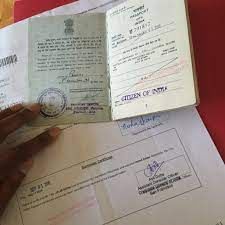
Why in News?
Between 2011 and 2022, close to 70,000 Indians surrendered their passports at regional passport offices (RPOs) across the country.
About
- The Ministry of External Affairs (MEA) reveals data in response to an RTI.
- With eight states – Goa, Punjab, Gujarat, Maharashtra, Kerala, Tamil Nadu, Delhi and Chandigarh – accounting for over 90 per cent of the surrendered documents.
- As many as 40.45 per cent of the 69,303 passports that were given up in this period were surrendered at the RPO in Goa followed by Punjab.
- Goa has consistently topped the list of states with the highest number of surrendered passports, except for 2012 and 2013, when Gujarat had the maximum numbers.
- The MEA data presented in the Lok Sabha shows that on an average, 11,422 Indians renounced their Indian citizenship every month since 2011.
- Over 16 lakh Indians have renounced their Indian citizenship since 2011.
Why do People Relinquish Citizenship?
- The people leave their countries for better jobs and living conditions, and some are pushed out by climate change or unfavourable political situations at home.
- As the Indian diaspora around the world has increased in numbers, with newer generations holding passports of other countries, some older Indians are choosing to leave to be with family settled overseas.
- Some people who leave India may be fleeing the law or fear of legal action for alleged crimes. A 2020 report by the Global Wealth Migration Review showed that high net worth individuals around the world who renounce citizenship acquired at birth may do so for reasons of rising crime rates or the lack of business opportunities at home.
- Safety of women and children, lifestyle factors like climate and pollution, financial concerns including taxes, better healthcare for families and educational opportunities for children, and to escape oppressive governments.
- The post-Independence diasporic community has been going (out of India) for jobs and higher education.
- India stands at the 69th number on the passport power rank according to the world passport index. The higher the passport index ranking, the better access they get to travel visa-free to many countries.
Source: Indian Express
GS-III
Centre puts norms against ‘Dark Patterns’ in Online Ads
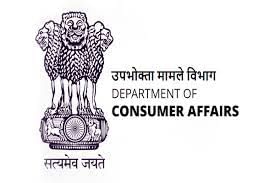
Why in News?
The Department of Consumer Affairs (DoCA) and the Advertising Standards Council of India (ASCI) have joined forces to tackle unethical advertising practices in India.
- Within the next two months, the authorities plan to release guidelines to combat dark patterns in Indian advertising.
Understanding Dark Patterns
- Dark patterns are manipulative marketing techniques that deceive customers through unethical practices.
- They encompass a wide range of tactics, including creating false urgency, employing subscription traps, and sneaking items into the checkout basket, using disguised advertising, and manipulating prices during checkout.
Types of dark patterns advertising
- Disguised ads: Presenting advertisements in a way that makes them look like regular content or organic recommendations, deceiving users into engaging with promotional material unknowingly.
- False urgency: Creating a sense of urgency by displaying countdown timers, limited-time offers, or stock availability to pressure consumers into making quick decisions without fully considering their options.
- Sneak into basket: Adding additional products or services to the shopping cart without the user’s explicit consent or knowledge, often through pre-selected checkboxes or hidden options.
- Hidden costs: Concealing or downplaying additional fees, charges, or subscriptions until the final stages of the checkout process, misleading consumers about the actual cost of a product or service.
- Confirm-shaming: Using manipulative language or guilt-tripping tactics to pressure users into taking a specific action they may not want to, such as subscribing to newsletters or sharing personal information.
- Roach motel: Making it easy for users to sign up for a service but intentionally creating barriers or complexities when they try to cancel or unsubscribe, making it difficult for them to leave.
Consequences of such ads
Dark patterns can lead to unintended purchases, addiction and overuse of products or services, and privacy violations.
- Unintended purchases: Dark patterns can manipulate consumers into making purchases they did not intend to make, leading to unnecessary expenses and financial strain.
- Addiction and overuse: Some dark patterns are designed to create addictive behaviors, keeping consumers engaged with a product or service beyond what is healthy or necessary.
- Privacy violations: Dark patterns may deceive consumers into unknowingly sharing sensitive personal information, compromising their privacy and leaving them vulnerable to data breaches or identity theft.
- Psychological manipulation: Dark patterns exploit cognitive biases and psychological vulnerabilities to manipulate consumer behavior, leading to decisions that are not based on informed choices but rather on emotional manipulation.
Why discuss this?
- Rapid growth of the Indian online space: The substantial expansion of the online sector in India raises concerns about the potential harm caused by dark patterns.
- Dominance of digital platforms: With digital platforms becoming the primary source of information, goods, and services for consumers, the manipulation of UI/UX design and online choice architecture can significantly impact consumer well-being.
Industry’s Role in Self-Regulation
- Importance of self-regulation: The consensus among stakeholders is that self-regulation within the industry is crucial to effectively address and counter dark patterns.
- Sectors to self-regulate: Various sectors, including online shopping, e-ticketing, restaurants, and travel, can adopt self-regulatory measures.
Way forward
- Providing tools for informed choices: Stakeholders suggested equipping users with browser extensions that can help detect and block dark patterns, enabling them to make more informed decisions.
- Encouraging reporting: Users are encouraged to report instances of dark patterns, and efforts will be made to raise awareness among small and medium-scale merchants about these deceptive practices.
- Consensus on self-regulation: All stakeholders unanimously agreed that industry self-regulation plays a pivotal role in countering deceptive online practices and protecting consumers’ interests.
- Commitment to consumer protection: The meeting concluded with a commitment to continue exploring ways to counter dark patterns and safeguard consumer rights and interests.
Source: PIB
Human-animal Conflict
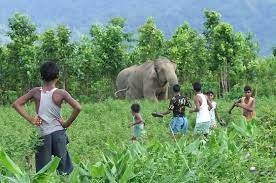
Why in News?
Debrigarh, a wildlife sanctuary in Odisha, has been made free from any human settlement following relocations of forest-dwellers.
- The positive impact of this relocation was a visible drop in incidences of man-animal conflict.
What is Human-wildlife conflict?
- It's an encounter between humans and wildlife which leads to negative results, such as loss of property, livelihoods, and even life.
A Recurring episode
- The man-animal conflict was at its highest during 2022 over 100 humans lost their lives in Maharashtra.
- According to the data starting from 2000 to 2022, a total of 1,054 people fell victim to wildlife attacks, while an additional 5,112 individuals were injured in such attacks in Uttarakhand.
Factors causing Human-Animal conflict
- Urbanisation and Agricultural expansion: Increased pressure on forest resources due to urbanization and expansion of agriculture is leading to increased encounters between humans and animals.
- Lack of Protected areas: A new report by WWF and UNEP has found that 35 per cent of India’s tiger ranges currently lie outside protected areas.
- Climate change: Climate change induced extreme weather events like droughts and heat waves is causing animals to move outside forests in search of water.
- Increase in eco-tourism: Pristine forest resources are being disturbed in the wake of weekend holidays in the forest areas.
Impacts of Human-Animal conflict
- A 2019 report by Frontiers in Ecology and Evolution, titled ‘Human-Elephant conflict: A review of current management strategies and future directions’ suggested that "India’s cost of human–elephant conflict is estimated at 1 million hectares of destroyed crops, 10,000 to 15,000 damaged properties, 400 human deaths, and 100 dead elephants per year."
- Increase in Road and Railways Accidents due to infrastructure development in forested areas.
Steps Taken by Government
- Ministry for Environment, Forest and Climate Change has released 14 guidelines to address Human-Wildlife Conflict (HWC), which includes Guidelines for Cooperation between the Forest and Media sector in India, Crowd Management in Human-Wildlife Conflict Related Situations and Addressing Health Emergencies and Potential Health Risks Arising Out of Human—Wildlife Conflict Situations by Taking a One Health Approach.
- Wildlife Protection Act 1972: It lays down the rules and regulations for the conservation and protection of Animals in India.
- Plan Bee: It is adopted by the Northeast Frontier Railway (NFR) which is a unique method to keep elephants away from railway tracks and plans are afoot to implement it all over the country to save the lives of elephants.
Way Ahead
- Building trust among communities: The communication and interaction between the forest department and the locals has to be improved so that they can be sensitized about the issues and animals.
- Wildlife corridors: Corridors allow animals to freely move from one habitat patch to another without crossing human-caused barriers which can put animals, and potentially humans, in danger.
- Increase in Protected areas: To conserve the animals and avoid any human-animal interaction more protected areas need to be developed by the Government.
- Other measures: Includes barriers (fences, nets, trenches), guarding and early-warning systems, deterrents and repellents (sirens, lights, beehives), translocation (moving wildlife), compensation or insurance, providing risk-reducing alternatives, as well as managing tensions between stakeholders involved in these situations.
Source: PIB
Green Credit Programme (GCP)

Why in News?
Recently, the Union Ministry of Environment, Forests and Climate Change have notified draft rules for ‘Green Credit’.
Background:-
- The ministry proposed the draft Green Credit Programme Implementation Rules 2023 in a notification issued on June 26, 2023.
- It has invited objections and suggestions within 60 days.
About Green Credit Programme (GCP):-
- Launched: 2023.
- Finance Minister Nirmala Sitharaman had launched “Green Credit Programme”(GCP) in Union Budget 2023-24.
- Objective: to create a market-based mechanism for undertaking environment-friendly activities such as afforestation programmes, and water conservation by providing additional incentives in the form of green credits.
- Green Credit: it is an incentive that individuals, farmer-producer organisations (FPO), industries, and rural and urban local bodies, among other stakeholders, will be able to earn for environment-positive actions.
- Ministry: Ministry of Environment, Forests and Climate Change.
- It will be launched at the national level to incentivize voluntary environmental actions of various stakeholders.
- It will encourage private sector industries by taking actions, which are able to converge with activities relevant to generating or buying Green Credits.
Governance Structure of GCP:-
GCP Administrator
- The Indian Council of Forestry Research and Education (ICFRE) will be the administrator of GCP.
- ICFRE: it is an autonomous organisation or governmental agency under the MoEFCC.
- Its aim is to generate, advance and disseminate scientific knowledge and technologies for ecological security, improved productivity, livelihood enhancement and sustainable use of forest resources through forestry research and education.
- It will manage, monitor and operate the entire programme.
Steering committee
- It will be set up to approve procedures for institutionalising the GCP, rules and regulations
- It will recommend it to the central government for issuance of a Green Credit Certificate.
- It will also determine the type and amount of fees and charges for the purpose of meeting the cost and expense towards implementation of GCP.
Working of GCP:-
- The GCP administrator will collect the environmental compensation and deposit it in a separate dedicated account.
- This fund shall be utilised for activities related to the implementation of GCP.
- For instance, an individual who undertakes tree plantation in an area, can earn green credits, which he can sell at the trading platform after validation by the steering committee.
Benefits of GCP:-
- It allows forests to be traded as a commodity.
- It allows the Forest Department to outsource one of its responsibilities of reforesting to non-government agencies.
- It will encourage plantation by individuals outside the traditional forest area.
- It will help in meeting international commitments such as sustainable development goals and nationally determined contributions.
Source: DTE
|
38 videos|5269 docs|1114 tests
|


